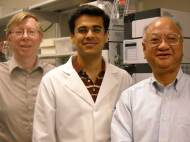Using modified E. coli to create succinic acid from soybean meal
 According to the ancient Chinese myth, in year 2853 before the common era, the legendary Emperor Shennong of China proclaimed that soybeans are one out of five sacred plants, and it is estimated that soybeans were a crucial crop in eastern Asia even before the written records. Aside its growing worldwide utilization in food industry, soybean could become an inexpensive new source of a widely used chemical for plastics, textiles, drugs, and solvents.
According to the ancient Chinese myth, in year 2853 before the common era, the legendary Emperor Shennong of China proclaimed that soybeans are one out of five sacred plants, and it is estimated that soybeans were a crucial crop in eastern Asia even before the written records. Aside its growing worldwide utilization in food industry, soybean could become an inexpensive new source of a widely used chemical for plastics, textiles, drugs, and solvents.
Several years ago, Rice University chemists George Bennett and Ka-Yiu San patented a process where genetically modified E. coli bacteria converts glucose into succinic acid in a way that is competitive with currently used process where succinic acid is produced from petroleum. Recently reported process developed by Bennett, San and Chandresh Thakker could enable the use of the indigestible parts of the soybean as the main source of material for a similar process of succinic acid production.
“We are trying to find a cheaper, renewable raw material to start with so the end product will be more profitable”, said Thakker, a research scientist in the Bennett lab at Rice’s BioScience Research Collaborative and lead author of the study. “The challenge has been to make this biomass process cost-competitive with the petrochemical methods people have been using for many years.”
While soybeans are mainly used to produce oils which are gaining popularity all across the planet, what’s left over after the production process are indigestible fiber and small carbohydrates. According to Bennett, Rice’s E. Dell Butcher Professor of Biochemistry and Cell Biology, these leftovers are used in small amounts in certain animal feeds, but they were considered as a very low-value material without practical uses.
While certain microbes naturally produce succinic acid from such feedstock, Rice researchers managed to modify E. coli’s metabolic pathways (by eliminating pathways that produce other chemicals like ethanol, for instance) in order to significantly improve the efficiency of the process where these previously mentioned leftovers from the soybean oil production are used to create succinic acid.
“There’s a fair amount of oilseed residuals available, including cottonseed carbohydrates, that are not used for any high-value product, and we’re in the space of microbial engineering to enable these sorts of materials to be used in a good way”, said Bennet, Rice’s E. Dell Butcher Professor of Biochemistry and Cell Biology.
The new microbes are engineered to metabolize a variety of sugars found in soybean meal could be adjusted to perform a similar task on other unutilized materials. Current method allows conversion at a very high yield ranging from 82 to 96% depending on the amount and type of converted material (soybean meal and soy solubles) and the type of modified E. coli strain which was used in the conversion process. Rice researchers believe that theoretical ideal of 1:1 ratio conversion could be achievable by industry once the process is more perfected.
For more information, read the article published in the journal Bioresource Technology: “Production of succinic acid by engineered E. coli strains using soybean carbohydrates as feedstock under aerobic fermentation conditions”.










Leave your response!